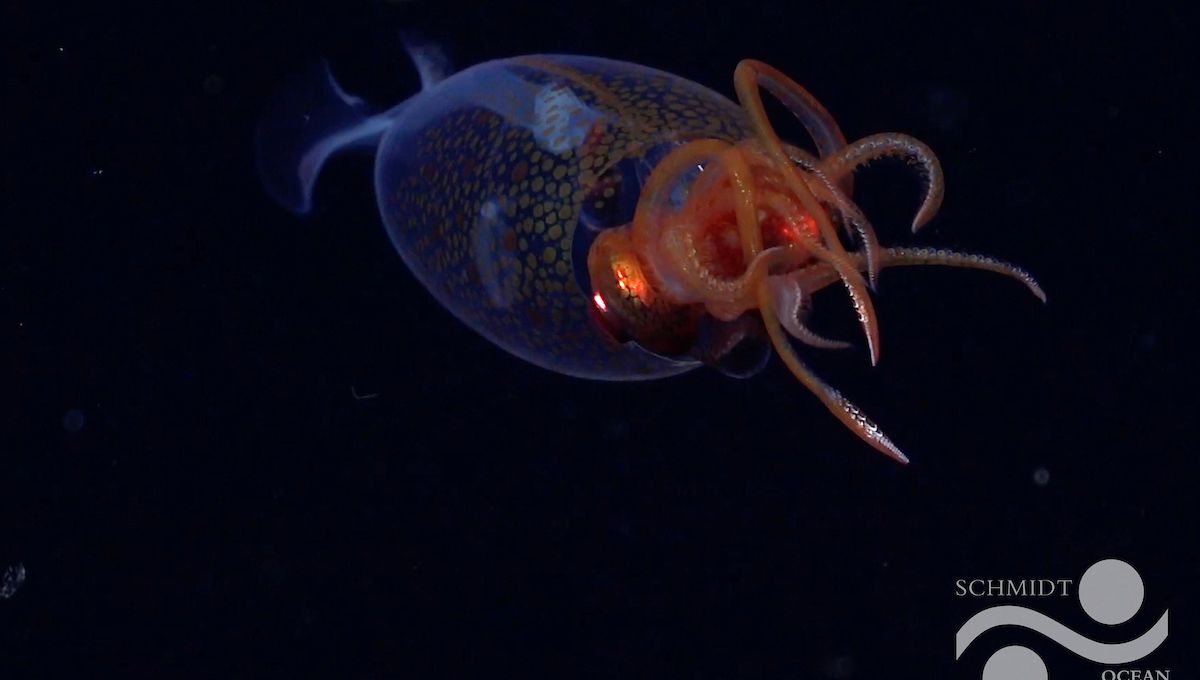
Behold: a live colossal squid in all its glory. After a century of searching, the extremely elusive cephalopod has been caught on camera alive in its natural habitat for the first time (and, for once, not inside the belly of a whale or washed up dead on a beach).
The juvenile squid was filmed on March 9 at a depth of 600 meters (1,968 feet) in waters off the South Sandwich Islands in the South Atlantic Ocean. Scientists onboard the Schmidt Ocean Institute’s research vessel Falkor (too) captured the video using a remotely operated vehicle (ROV) – and experts are very pleased with the results.
“It’s exciting to see the first in situ footage of a juvenile colossal and humbling to think that they have no idea that humans exist,” Dr Kat Bolstad, a cephalopod biologist at the Auckland University of Technology who consulted the team and helped to verify the species, said in a statement.
“For 100 years, we have mainly encountered them as prey remains in whale and seabird stomachs and as predators of harvested toothfish.”
Colossal squids (Mesonychoteuthis hamiltoni) are a member of the glass squid family (Cranchiidae), hence this specimen’s see-through body. Because sightings are so rare, much of what we know about its behavior and life cycle remains a mystery. However, scientists believe that as these squids mature, their once-transparent bodies gradually darken with age.
The filmed individual is a young’un, just 30 centimeters (under 1 foot) long, but the species can grow up to 7 meters (23 feet) in length and can weigh as much as 500 kilograms (1,100 lbs), making them the heaviest invertebrate on the planet. Giant squids (Architeuthis dux) are longer at up to 13 meters (43 feet) but not as hefty at about half that weight.
This is not what many of us would have pictured as what we might see the first time we saw a colossal squid.
Dr Kat Bolstad
The researchers, however, are not disappointed that this individual is a little bit puny. Speaking at a media conference, Dr Bolstad said, “I really love that this is the first view that we have of the colossal squid.”
“This is not what many of us would have pictured as what we might see the first time we saw a colossal squid. We know how large the species can grow. We know it’s the heaviest invertebrate on the planet […] This is a great example of the beauty of many deep-sea animals, in contrast to the ‘stuff of nightmares’ clickbait titles we get when the media covers these animals,” she added.
Between December 2022 and March 2023, the nonprofit group Kolossal embarked on an expedition to Antarctica in search of the elusive colossal squid. During their journey, they captured footage of a glass squid measuring 10–12 centimeters (3.9–4.7 inches), which they believed might have been a juvenile colossal squid. However, its exact identity was in doubt because the video quality wasn’t ideal – it could also have been an adult Galiteuthis glacialis (another glass squid) or even a previously unknown species.
This latest footage is much clearer and more certain. Dr Bolstad and Dr Aaron Evans, another independent expert on the glass squid family, managed to confirm the individual was a colossal squid after noting the presence of hooks in the middle of their eight arms. This, they say, is a notable feature that helps to distinguish them from other more common squid.
“It’s incredible that we can leverage the power of the taxonomic community through R/V Falkor (too) telepresence while we are out at sea,” said the expedition’s chief scientist, Dr Michelle Taylor of the University of Essex, who led The Nippon Foundation-Nekton Ocean Census team on the South Sandwich Islands expedition. “The Ocean Census international science network is proud to work together with the Schmidt Ocean Institute to accelerate species discovery and expand our knowledge of ocean life, live online with the world’s science community.”
Incredibly, the discovery coincides with the 100th anniversary of the identification and formal naming of the colossal squid. The species was first discovered in 1925 when body parts of a strange squid were found in the guts of a sperm whale near the Shetland Islands. The pieces were sent back to the British Museum, where they were formally identified as a new species: Mesonychoteuthis hamiltoni.
It only took a century, but science has finally managed to see a live one in the flesh.
Source Link: After 100 Years Of Searching, A Live Colossal Squid Has Been Filmed For First Time